BAE System Bundle
How Does BAE Systems Thrive in a World of Geopolitical Uncertainty?
BAE Systems, a titan in the defense and aerospace industry, is currently experiencing remarkable financial growth, with a 14% revenue increase in 2024 and a record order backlog. This success, fueled by global demand and strategic foresight, positions BAE Systems as a key player for investors and industry watchers. Understanding BAE System SWOT Analysis is crucial to grasp the company's strengths and opportunities.
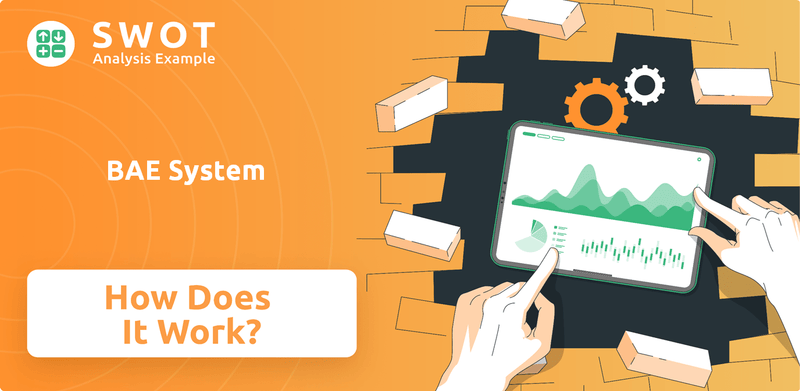
Delving into How BAE Systems works reveals a complex, yet highly effective, business model built on long-term government contracts and cutting-edge technology. The company's ability to adapt to evolving geopolitical landscapes and secure lucrative defense contracts is central to its sustained financial performance. With significant operations in the US, UK, and beyond, BAE Systems' strategic focus on innovation and its diverse product portfolio, including BAE Systems products, ensures its continued relevance and growth potential in the defense sector. For those interested in BAE Systems jobs, understanding the company's structure is key.
What Are the Key Operations Driving BAE System’s Success?
BAE Systems operates as a global leader in defense, aerospace, and security, delivering advanced solutions to governments, armed forces, and commercial clients worldwide. The company's core business revolves around designing, manufacturing, and supporting a wide array of products and services, from fighter jets and submarines to armored vehicles and advanced electronics. This diversified approach allows BAE Systems to cater to various defense needs and maintain a strong market presence.
Its value proposition lies in providing cutting-edge technology and reliable solutions that meet the evolving demands of modern warfare and security challenges. Through continuous innovation, strategic partnerships, and a commitment to quality, BAE Systems aims to offer its customers superior performance, enhanced capabilities, and mission-critical support. The company's focus on long-term contracts and relationships with governments ensures a stable revenue stream and supports its growth strategy.
The company's operations are structured to cover the entire lifecycle of its products and services, from initial research and development to manufacturing, sales, and ongoing customer support. BAE Systems emphasizes a collaborative approach, working closely with key partners such as government agencies, defense contractors, and research institutions to co-develop next-generation capabilities. This integrated approach allows the company to stay at the forefront of technological advancements and deliver value to its stakeholders.
BAE Systems offers a wide range of products and services. These include air, land, and naval platforms, such as fighter jets, aircraft, submarines, and armored vehicles. The company also provides advanced electronics, cybersecurity, and intelligence services. The company's portfolio is designed to meet the diverse needs of its customers.
The operational processes at BAE Systems are comprehensive, encompassing research and development, product design and engineering, manufacturing and production, quality assurance, supply chain management, sales and marketing, and customer support. The company's focus on continuous improvement and innovation ensures it remains competitive.
BAE Systems emphasizes a cross-functional strategy involving key partners such as government agencies, defense contractors, research institutions, and engineering firms. This collaborative approach enables the co-development of next-generation capabilities and helps the company stay at the forefront of technological advancements. These partnerships are crucial for innovation.
BAE Systems' supply chain is largely domestic for its US operations, mitigating the impact of potential tariffs. The company's continuous investment in technology, such as AI and autonomous systems, ensures its offerings meet evolving warfare needs. This focus on innovation allows BAE Systems to offer advanced defense technology solutions.
In 2024, BAE Systems demonstrated strong financial performance, with the Electronic Systems segment, boosted by the acquisition of Ball Aerospace, seeing sales rise by 35% to £7.2 billion. This growth was driven by precision strike, sensing, and commercial aviation. The Platforms & Services segment also contributed significantly, growing by 15% in 2024. These figures highlight the company's robust market position and its ability to capitalize on defense and aerospace opportunities.
- BAE Systems' commitment to innovation and strategic partnerships ensures its offerings meet evolving warfare needs.
- The company's focus on advanced defense technology solutions, cybersecurity, and intelligence services differentiates it from competitors.
- BAE Systems' financial performance reflects its strong market position and ability to capitalize on defense and aerospace opportunities.
- For more details about the company's history, you can read the Brief History of BAE System.
BAE System SWOT Analysis
- Complete SWOT Breakdown
- Fully Customizable
- Editable in Excel & Word
- Professional Formatting
- Investor-Ready Format
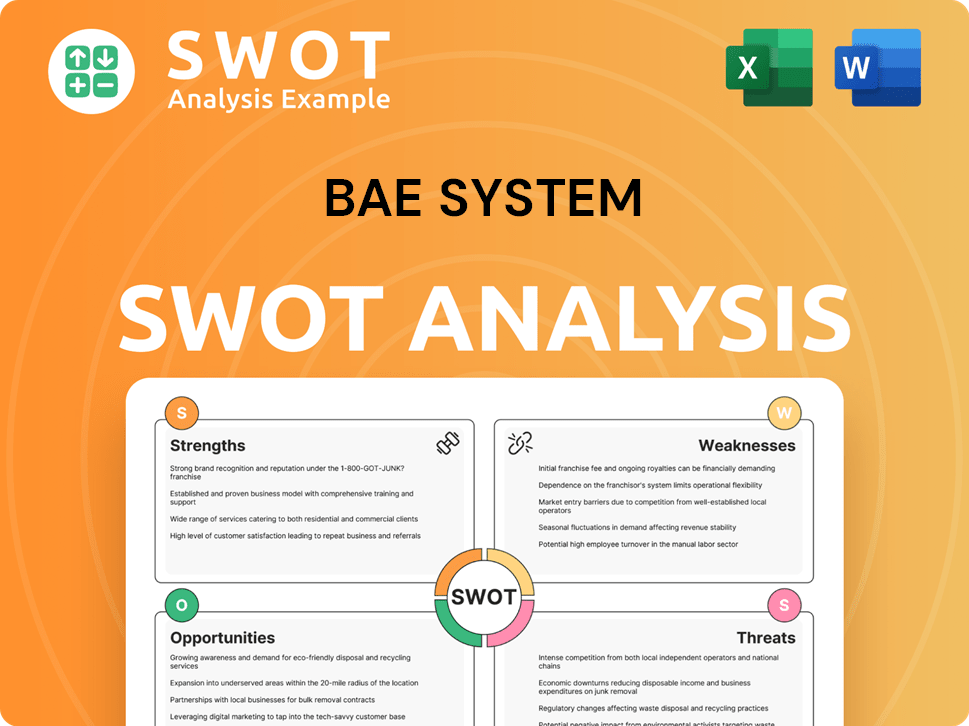
How Does BAE System Make Money?
Understanding the revenue streams and monetization strategies of BAE Systems is crucial for grasping how this prominent defense and security company operates. The company's financial performance is largely influenced by its ability to secure and execute long-term contracts, primarily with government defense departments worldwide. This approach provides a degree of predictability in its earnings and supports strategic investment in research and development.
BAE Systems reported total revenue of £28.3 billion for the full year 2024, marking a 14% increase from the previous year. The company anticipates further growth, with sales forecast to increase by 7-9% in 2025, potentially exceeding £30 billion. This growth trajectory underscores the company's strong position in the defense market and its ability to capitalize on global security demands.
A deep dive into How BAE Systems works reveals a diversified approach to generating income, ensuring financial stability and resilience. The company's ability to secure and manage large-scale defense contracts, coupled with strategic acquisitions and a focus on technological innovation, positions it as a key player in the global defense industry.
BAE Systems generates revenue through several key channels, each contributing significantly to its overall financial performance. These streams are supported by long-term contracts and strategic investments, ensuring a consistent flow of income. The company's diverse revenue model is a key factor in its sustained growth and market leadership.
- Product Sales: This includes the design, manufacturing, and sale of military equipment. In 2022, products generated approximately £14.2 billion, or 61% of total revenue. BAE Systems products include fighter jets, submarines, aircraft, and armored vehicles.
- Services and Support: The company provides ongoing support, maintenance, and upgrades for its installed base of defense systems. In 2022, services accounted for about £8.9 billion, or 39% of total revenue.
- Research and Development Funding: BAE Systems receives funding for R&D projects, contributing to its revenue and fostering innovation. The company invested over £1 billion in capital expenditure in 2024 for R&D and capacity expansion.
- Cybersecurity and Intelligence Solutions: This segment provides advanced cybersecurity and intelligence services. Sales in this sector grew by 6% to £2.4 billion in 2024.
- Strategic Acquisitions: Mergers and acquisitions, such as the purchase of Ball Aerospace in February 2024 for $5.5 billion (£4.4 billion), have been significant drivers of revenue growth.
BAE System PESTLE Analysis
- Covers All 6 PESTLE Categories
- No Research Needed – Save Hours of Work
- Built by Experts, Trusted by Consultants
- Instant Download, Ready to Use
- 100% Editable, Fully Customizable
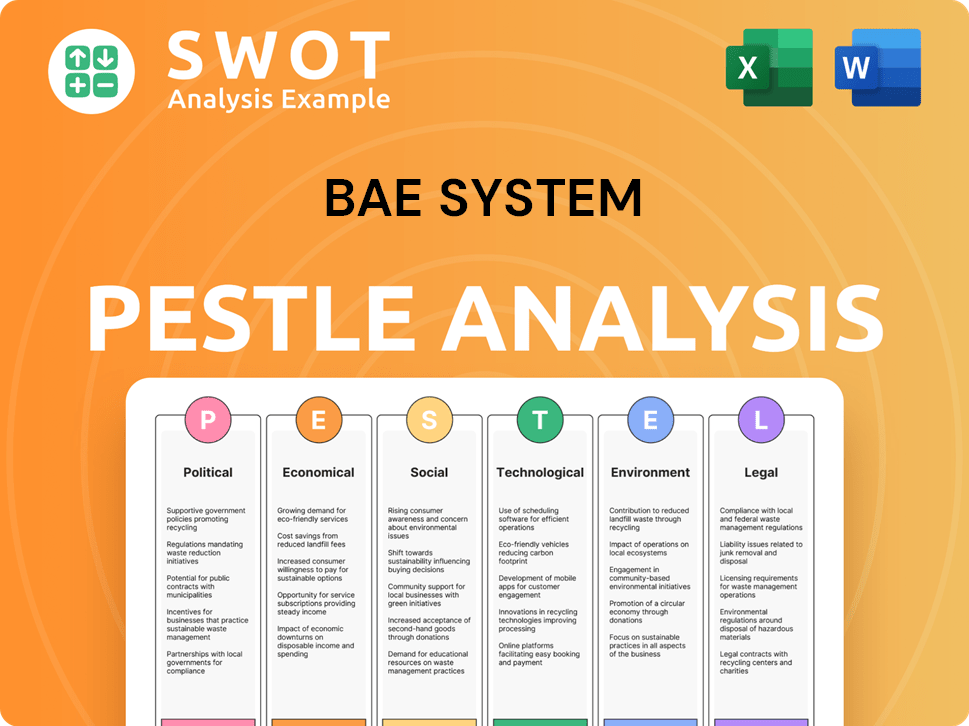
Which Strategic Decisions Have Shaped BAE System’s Business Model?
The evolution of BAE Systems, a prominent player in the defense and aerospace industry, is marked by significant milestones and strategic shifts. These moves have not only shaped its operational capabilities but also had a direct impact on its financial performance. The company's strategic decisions, particularly in acquisitions and contract wins, highlight its ambition to strengthen its market position and expand its technological capabilities. This approach is crucial for maintaining a competitive edge in a rapidly evolving global landscape.
BAE Systems' commitment to innovation and its ability to secure substantial contracts demonstrate its resilience and forward-thinking approach. The company's focus on research and development, along with its global presence, allows it to adapt to changing market dynamics and address the evolving needs of its customers. These factors are critical for sustaining long-term growth and maintaining a leading position in the defense sector. Furthermore, the company's strategic investments and operational improvements are designed to enhance its efficiency and competitiveness.
The company's financial success is underpinned by its strategic investments and operational efficiencies. The acquisition of Ball Aerospace in 2024, for instance, significantly boosted its capabilities in the space sector. This move, alongside other strategic initiatives, contributed to record profits exceeding £3 billion in 2024. Moreover, BAE Systems' ability to secure large-scale contracts, such as the $2.5 billion deal for CV90 combat vehicles, underscores its strong market position and ability to meet the demands of its clients. These factors collectively contribute to the company's robust financial health and its potential for continued growth.
In 2024, BAE Systems acquired Ball Aerospace (now Space & Mission Systems) for $5.5 billion, significantly expanding its space sector capabilities. The company also secured major contracts, including a $2.5 billion deal for CV90 combat vehicles with Sweden and Denmark. These strategic moves have been pivotal in driving growth and enhancing its market position.
BAE Systems is investing over $200 million to expand capacity for its Hägglunds business, which is responsible for CV90 production. The company is also advancing the construction of a new ship build hall in Govan, UK, slated for completion in 2025. These investments are designed to enhance operational capabilities and meet growing demand.
The company's financial performance in 2024 was robust, with record profits exceeding £3 billion. BAE Systems' order backlog reached a record £77.8 billion, demonstrating strong demand and long-term revenue visibility. This strong financial position enables the company to invest in future growth and innovation.
BAE Systems is focused on developing advanced technologies, including AI and autonomous systems. The company is also pursuing strategic partnerships, such as the one with Hanwha Systems announced in June 2025, to develop advanced multi-sensor satellite systems. These initiatives are crucial for maintaining a competitive edge.
BAE Systems' competitive edge stems from its diverse portfolio across air, land, sea, and cyber domains, coupled with a global presence in over 40 countries. The company's commitment to innovation and substantial investment in research and development, focusing on advanced technologies, further strengthens its market position. Its integrated business model enables it to deliver comprehensive solutions and adapt to new trends and threats.
- Extensive portfolio across air, land, sea, and cyber domains.
- Global footprint with operations in over 40 countries and approximately 107,000 employees.
- Strong relationships with governments and defense agencies, often involving long-term contracts.
- Commitment to innovation and substantial R&D investments in areas like AI and autonomous systems.
- Integrated business model leveraging cutting-edge technology for comprehensive solutions.
BAE System Business Model Canvas
- Complete 9-Block Business Model Canvas
- Effortlessly Communicate Your Business Strategy
- Investor-Ready BMC Format
- 100% Editable and Customizable
- Clear and Structured Layout
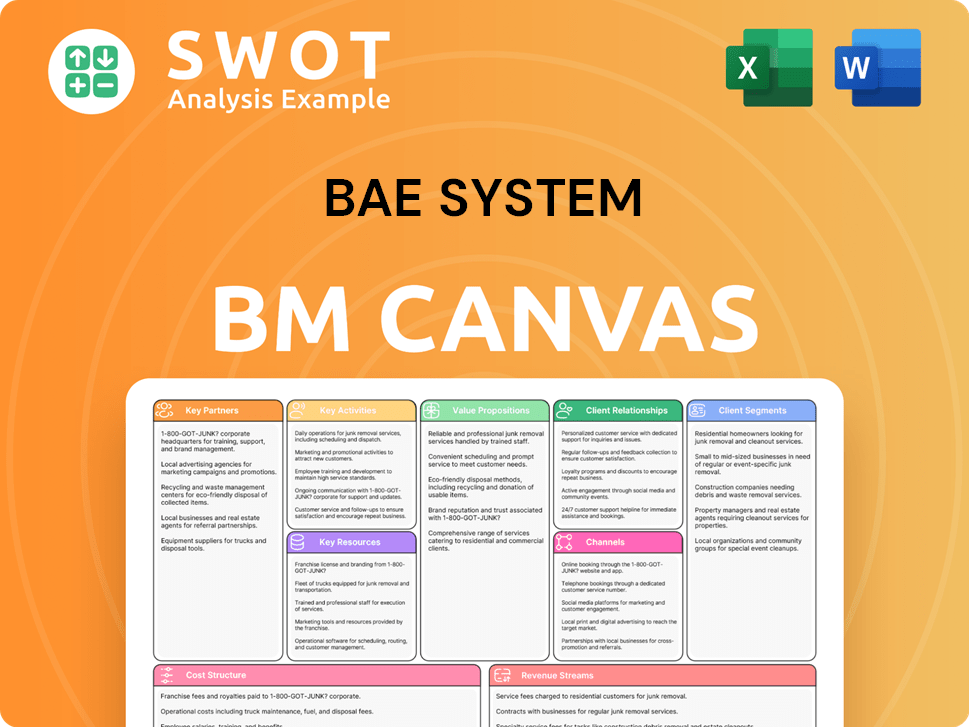
How Is BAE System Positioning Itself for Continued Success?
As a leading player in the global defense, aerospace, and security sector, BAE Systems holds a commanding position. It is the largest defense contractor in Europe and a significant force worldwide. Its market share is bolstered by a nearly 50% revenue contribution from the US, alongside strong presences in the UK, Saudi Arabia, and Australia. The company benefits from high customer loyalty, thanks to long-term contracts with governments and armed forces globally. A record order backlog of £77.8 billion at the end of 2024 highlights substantial future revenue and profitability visibility for BAE Systems.
However, the company faces several risks. Geopolitical shifts can influence procurement decisions. While current US tariffs haven't significantly affected BAE Systems due to domestic supply chains, future trade policies could pose risks. The nature of defense contracts means profitability is susceptible to changes in estimated future costs and potential supply chain disruptions. The defense sector is also subject to strict regulatory changes and intense competition. To learn more about the company's approach to the market, you can check out the Marketing Strategy of BAE System.
BAE Systems is a global leader in defense and security, with a strong market share and a diverse customer base. It operates in a highly competitive environment, but its long-term contracts and technological capabilities provide a competitive edge. The company's position is supported by its extensive order backlog and strategic investments.
BAE Systems faces risks related to geopolitical instability, changes in government spending, and supply chain disruptions. The company is subject to strict regulations and intense competition from other major defense contractors. Changes in contract terms and cost overruns can also affect profitability.
BAE Systems anticipates continued growth, with sales expected to increase by 7-9% in 2025. Strategic initiatives include capacity expansion, such as new manufacturing facilities, and increased investment in R&D. The company plans to recruit over 2,400 new employees in 2025 to support future demands.
Underlying operating profits are projected to rise by 8-10% from £3.0 billion. Free cash flow is expected to exceed £1.1 billion in 2025. The company's strategy focuses on sustaining and growing its defense business, expanding into adjacent markets, and developing its international presence.
BAE Systems is investing heavily in research and development, focusing on key technology areas to maintain its competitive edge. This includes electronic warfare, autonomy, laser-guided weapons, and space solutions. The company is also expanding its manufacturing capabilities.
- Ongoing investments in capacity expansion, like new facilities in South Wales and Glasgow.
- Focus on key technology areas such as electronic warfare and autonomy.
- Recruiting over 2,400 new employees in apprentice, undergraduate, and graduate roles in 2025.
- Sustaining and growing the defense business, expanding into adjacent markets, and developing its international presence.
BAE System Porter's Five Forces Analysis
- Covers All 5 Competitive Forces in Detail
- Structured for Consultants, Students, and Founders
- 100% Editable in Microsoft Word & Excel
- Instant Digital Download – Use Immediately
- Compatible with Mac & PC – Fully Unlocked
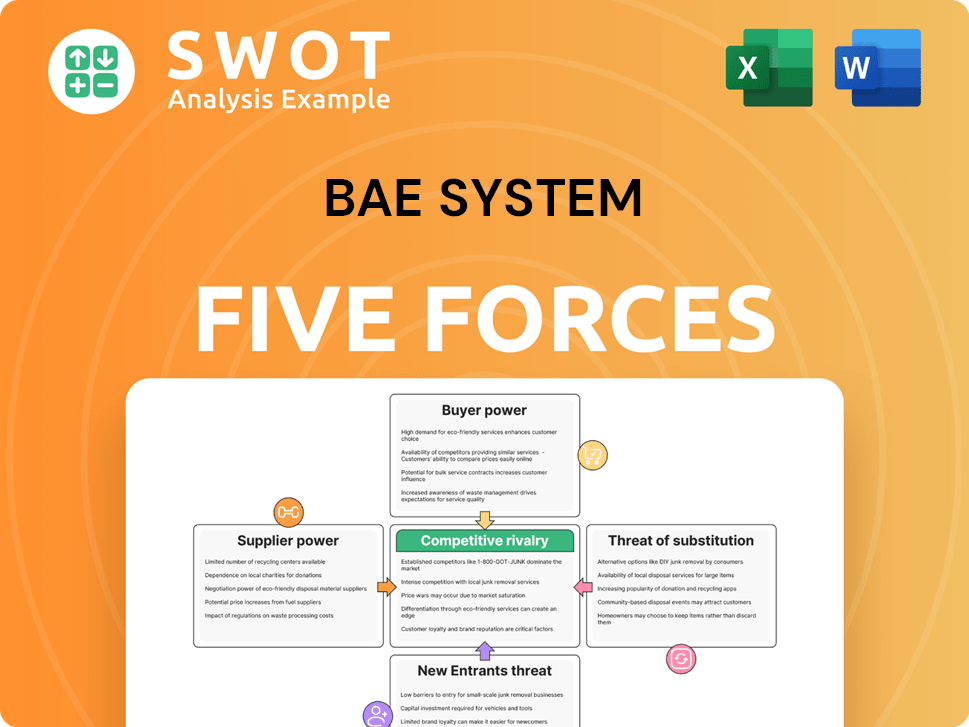
Related Blogs
- What are Mission Vision & Core Values of BAE System Company?
- What is Competitive Landscape of BAE System Company?
- What is Growth Strategy and Future Prospects of BAE System Company?
- What is Sales and Marketing Strategy of BAE System Company?
- What is Brief History of BAE System Company?
- Who Owns BAE System Company?
- What is Customer Demographics and Target Market of BAE System Company?
Disclaimer
All information, articles, and product details provided on this website are for general informational and educational purposes only. We do not claim any ownership over, nor do we intend to infringe upon, any trademarks, copyrights, logos, brand names, or other intellectual property mentioned or depicted on this site. Such intellectual property remains the property of its respective owners, and any references here are made solely for identification or informational purposes, without implying any affiliation, endorsement, or partnership.
We make no representations or warranties, express or implied, regarding the accuracy, completeness, or suitability of any content or products presented. Nothing on this website should be construed as legal, tax, investment, financial, medical, or other professional advice. In addition, no part of this site—including articles or product references—constitutes a solicitation, recommendation, endorsement, advertisement, or offer to buy or sell any securities, franchises, or other financial instruments, particularly in jurisdictions where such activity would be unlawful.
All content is of a general nature and may not address the specific circumstances of any individual or entity. It is not a substitute for professional advice or services. Any actions you take based on the information provided here are strictly at your own risk. You accept full responsibility for any decisions or outcomes arising from your use of this website and agree to release us from any liability in connection with your use of, or reliance upon, the content or products found herein.